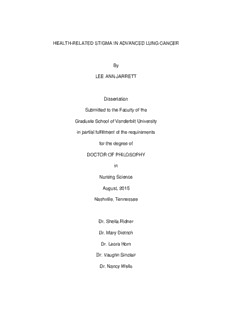
HEALTH-RELATED STIGMA IN ADVANCED LUNG CANCER By LEE ANN JARRETT Dissertation ... PDF
Preview HEALTH-RELATED STIGMA IN ADVANCED LUNG CANCER By LEE ANN JARRETT Dissertation ...
HEALTH-RELATED STIGMA IN ADVANCED LUNG CANCER By LEE ANN JARRETT Dissertation Submitted to the Faculty of the Graduate School of Vanderbilt University in partial fulfillment of the requirements for the degree of DOCTOR OF PHILOSOPHY in Nursing Science August, 2015 Nashville, Tennessee Dr. Sheila Ridner Dr. Mary Dietrich Dr. Leora Horn Dr. Vaughn Sinclair Dr. Nancy Wells Copyright © 2015 Lee Ann Jarrett All Rights Reserved ii Dedicated to my Mom and Bob iii ACKNOWLEDGEMENTS I would like to express my deepest and most heartfelt appreciation to my mentor and dissertation chair Dr. Sheila H. Ridner. As her project coordinator I gained valuable research experience and knowledge that helped to me to become an independent nurse scientist. As her student she has been an amazing example of a teacher and scholar. As my friend she has supported me through many significant life changes that have taken place throughout my time as a PhD student and I will be forever grateful for all that she has done for me. I would also like to thank the other members of my dissertation committee for their time, effort, and assistance throughout the years: Drs. Mary Dietrich, Leora Horn, Vaughn Sinclair, and Nancy Wells. Each member of my committee has offered valuable insight and assistance in the development and execution of my dissertation study and I have learned a great deal from each of them. I would like to thank the American Cancer Society and the Vanderbilt School of Nursing for providing financial support for this project. I would also like to thank the Lung Cancer Alliance and the LUNGevity foundation for assistance in nationwide recruitment of patients with lung cancer. I would like to thank my family for their support throughout my many years of school. My Mom always inspired me to dare to be different. Her diagnosis of and subsequent death due to lung cancer was the inspiration for me to pursue my PhD in nursing and to work with patients who have also been diagnosed with lung cancer. My husband, Dr. Michael Johnson, has spent many hours proofreading my dissertation and listening to my joy and pain throughout this process. My son, Arlo, has provided a welcomed escape from the hours of hard work over the last two years. Finally, my iv grandfather, Bob, has been the only person in my life who has been here from my first day of Kindergarten to the defense of my dissertation. As my dissertation on lung cancer comes to a close he begins his own journey with the disease. I am forever thankful for the love and endless support he has given me through the years. v TABLE OF CONTENTS DEDICATION iii ACKNOWLEDGEMENTS iv LIST OF TABLES viii LIST OF FIGURES x Chapter I. INTRODUCTION 1 a. Statement of Problem 2 b. Purpose of the Study 3 c. Research Questions 4 d. Significance of the Issue 4 i. Significance to Society 4 ii. Significance to Healthcare 14 iii. Significance to Science of Nursing 15 II. LITERATURE REVIEW 18 a. Theoretical Framework 18 b. Definition of Terms 21 c. Critical Analysis of Literature 24 III. METHODOLOGY 80 a. Research Design and Assumptions 80 b. Research Setting 80 c. Sample and Sampling Plan 81 i. Nature and Size of Sample 81 ii. Criteria for Sample Selection 81 iii. Participant Recruitment 82 iv. Human Subjects Protection 83 d. Data Collection Methods 84 i. Procedures 84 ii. Instruments 85 e. Data Analysis 88 vi IV. FINDINGS 90 a. Sample Characteristics 90 b. Findings Related to Study Aims 96 V. DISCUSSION 104 a. Credibility, Rigor, and Validity of Design 104 b. Sample Characteristics 107 c. Aims 108 d. Study Strengths and Limitations 118 e. Implications 121 f. Recommendations for Future Research 123 Appendix 125 A. PATIENT CONTACT SCRIPT 125 B. SCREENING FORM 130 C. DEMOGRAPHIC AND BACKGROUND INFORMATION 131 D. STIGMA SCALE 133 E. SOCIAL CONSTRAINTS SCALE 134 F. M.D. ANDERSON SYMPTON INVENTORY-LUNG CANCER 136 G. NCCN DISTRESS THERMOMETER 138 H. HOSPITAL ANXIETY AND DEPRESSION SCALE 139 I. MEDICAL OUTCOMES SURVEY—SOCIAL SUPPORT SURVEY 142 J. QUALITY OF LIFE (LINEAR ANALOG SELF-ASSESSMENT) 144 REFERENCES 145 vii LIST OF TABLES Table 1. Key Concepts Related to the Phenomenon 21 2. Analysis of Methods Used to Study Stigma in Lung Cancer 25 3. Measures and Scales to Study Stigma in Lung Cancer 34 4. Analysis of Methods Used to Study Symptoms in Lung Cancer 37 5. Measures and Scales to Study Symptoms in Lung Cancer 48 6. Analysis of Methods Used to Study Psychological Symptoms in Lung Cancer 52 7. Measures and Scales to Study Psychological Symptoms in Lung Cancer 65 8. Analysis of Methods Used to Study Social Support in Lung Cancer 69 9. Measures and Scales to Study Social Support in Lung Cancer 73 10. Data Resources and Data Collection Methods 88 11. Demographics of Study Sample 91 12. Health Behavior Characteristics 92 13. Sample Score on Stigma Scale 94 14. Internal Consistency and Sample Scores on the Instruments 96 15. Correlations between External HRS and Physical Symptoms, Psychological Symptoms and Social Support 98 16. Correlations between External HRS and Domains of QOL 99 17. Correlations between Internal HRS and Physical Symptoms, Psychological Symptoms and Social Support 100 18. Correlations between Internal HRS and Social Support and QOL 100 19. Correlations between Physical Symptoms and Social Support and QOL 101 viii 20. Correlations between Depression and Social Support and QOL 102 21. Correlations between Anxiety and Social Support and QOL 102 22. Correlations between Distress and Social Support and QOL 103 ix LIST OF FIGURES Figure 1. The Theory of Unpleasant Symptoms 18 x
Description: